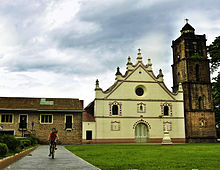San Vicente Ferrer Church (Dupax del Sur)
| Dupax del Sur Church | |
|---|---|
| San Vicente Ferrer Parish Church Iglesia Parroquial de San Vicente Ferrer |
|

Façade of the San Vicente Ferrer Church in Dupax del Sur, Nueva Vizcaya
|
|
| 16°17′06″N 121°05′29″E / 16.2851°N 121.0915°ECoordinates: 16°17′06″N 121°05′29″E / 16.2851°N 121.0915°E | |
| Location | Aritao-Quirino Road, Barangay Dopaj, Dupax del Sur |
| Country | Philippines |
| Denomination | Roman Catholic |
| History | |
| Dedication | Saint Vincent Ferrer |
| Architecture | |
| Status | Parish church |
| Functional status | Active |
| Heritage designation | National Cultural treasure |
| Designated | 2001 |
| Architect(s) | Father Manuel Corripio, OP |
| Architectural type | Church building |
| Style | Baroque |
| Completed | 1776 |
| Specifications | |
| Materials | Brick, Sand, Gravel, Cement, Steel |
| Administration | |
| Archdiocese | Tuguegarao |
| Diocese | Bayombong |
| Clergy | |
| Archbishop | Sergio Utleg |
| Bishop(s) | Sede Vacante |
The San Vicente Ferrer Parish Church (Tagalog: Simbahan ng Parokya ni San Vicente Ferrer; Spanish: Iglesia Parroquial de San Vicente Ferrer), commonly referred to as Dupax Church or Dupax del Sur Church, is an 18th-century Baroque church located at Brgy. Dopaj, Dupax del Sur, Nueva Vizcaya, Philippines. The parish church, under the advocation of Saint Vincent Ferrer, is under the jurisdiction of the Roman Catholic Diocese of Bayombong. The church complex has been declared a National Cultural Treasure by the National Museum of the Philippines in July 2001.
Dupax started as a mission by the Dominican Priests to convert the native group called Isinays into Christianity at around 1602. The Dominicans pushed through with the evangelization of the region until 1704 when the missions were turned over to the Augustinians because of lack of personnel. By 1740, the said missions in present-day Nueva Vizcaya were returned to the administration of the Dominicans.
An earlier church structure of modest design might have been erected before 1773 and records tell that the structure may have been reused as a schoolhouse after the erection of the present church at around 1773 by Father Manuel Corripio, OP. By this time, the church of Tuguegarao by Father Antonio Lobato, OP was already standing. Like the earlier Tuguegarao church, Father Corripio had the church of Dupax made of bricks and even had two kilns made near the church complex, one for firing bricks and the other for preparing lime. The current façade, which mimics the silhouette of the earlier Tuguegarao Cathedral and is reflected on the churches of Bayombong and Bambang in Nueva Vizcaya, dates back to 1776 while each level of the bell tower bears inscription of the years when which it must have been completed. Its original titular patron is the Nuestra Señora del Socorro but was replaced by San Vicente Ferrer soon after the mission was returned to the Dominicans.
...
Wikipedia
